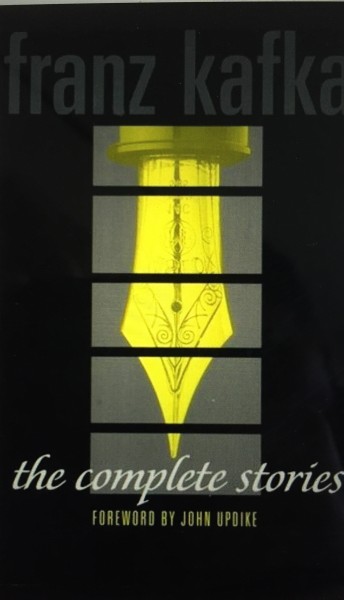
SmokeLong‘s “Flash, Back” series asks writers to discuss flash fiction that may be obscure or printed before the term “flash fiction” became popular, and tell us how these older or not widely-known works are meaningful. In this edition, Jennifer Fliss discusses the deliciously deep and ominous works of Franz Kafka. Submit your own “Flash, Back” or other flash-related essays on our Submittable page!
By Jennifer Fliss
Somewhere in the middling, flannel, acne-covered early nineties, I was introduced to Franz Kafka, via The Metamorphosis. As someone who didn’t particularly enjoy classic literature, Kafka was a welcome departure. The strangeness and the details left unexplained impressed upon me that part of the fun of reading is leaving something for the reader to parse out – a mystery in form and not only in subject matter. I quickly read through Kafka’s other stories, long and short. And it is in Kafka’s shorter works that I found exactly what I was looking for and what would influence my writing decades after.
Often this style of omission can be difficult for a reader in longer works. When reading novels, my mind wants to grasp onto tangible setting details and storytelling. In really short stories, there isn’t enough physical space for these things and requires the reader to fill in the blanks and work with the writer for a fully composed masterpiece and experience.
One hundred years ago, Kafka’s 775-word story, “A Fratricide” is a very early example of what we now have given the name, “flash fiction.”
The premise is of a man, Schmar, murdering his brother, Wese. The killing is premeditated. As he awaits his brother, we see him sharpening his blade, we feel him hot with nerves, we see what he is wearing; we are in very close narrative distance to Schmar. Also, of importance: Kafka gives us a witness, Pallas, who is watching in his bedclothes from his apartment window.
In this short piece, in a style similar to what we see in many flash pieces today, it is unclear who the narrator is. This is critical. The first line is everything, and is a tell for the reader: The evidence shows that this is how the murder was committed. This means – and I love it – that you can’t actually count on this being the objective truth. This is only what the evidence shows.
In “A Fratricide” there is also some wholly unbelievable dialogue after the murder transpires. Schmar rejoices aloud in the blood-letting. But the words don’t ring true. Presumably, it is what Pallas has reported. And who is Pallas? Kafka asks the reader this pointedly which I believe was Kafka’s way to say – hey, this guy may not be so innocent.
This is all a break from straightforward narrative. In flash fiction, we can do that since flash is often conceptual. Flash writers experiment with all kinds of form and in this way, Kafka does not disappoint.
In my flash, I love writing the intangibles. What can you not grasp onto that is keeping you in the story? Have you caught it in the end? Yes? No? Want to read it again to see if you can parse out the meaning? Because the work is so short, you can easily read and reread it and engage with it on multiple levels and reinterpretations. It can mean something to one reader and something entirely different to another. As a flash fiction writer, you present a stage, throw in some clues as to what your intentions are and leave the rest to the reader.
But you decide. Read the story yourself. It’s brilliant and it reads very modern. One thing to note though is that Kafka was doing it one hundred years ago, a time when James Joyce and Marcel Proust and E.M. Forster were on the scene. These authors were writing long epic novels (Proust’s Remembrance of Things Past is over 3000 pages!) filled with rambling sentences with nary a detail left out.
Of “A Fratricide,” others have said the three characters are personifications of Freud’s three elements of personality: id, ego, and superego. And if this was an English class, I’d say: yes, go there. Dig deep. Find meaning. See the obvious parallel to the biblical brothers, Cain and Abel. Look for the layers. But I also enjoy reading this story for the story directly put in front of me. That’s the beauty of flash fiction – it can be so many different things at once.
 Jennifer Fliss is a Seattle-based fiction and essay writer. Her work has appeared in or is forthcoming in PANK, The Rumpus, Bartleby Snopes, Necessary Fiction, and elsewhere. She recently won the Fiction Southeast Hell’s Belles Short Fiction Prize. She can be found on Twitter at @JFlissCreative or via her website, www.jenniferflisscreative.com
Jennifer Fliss is a Seattle-based fiction and essay writer. Her work has appeared in or is forthcoming in PANK, The Rumpus, Bartleby Snopes, Necessary Fiction, and elsewhere. She recently won the Fiction Southeast Hell’s Belles Short Fiction Prize. She can be found on Twitter at @JFlissCreative or via her website, www.jenniferflisscreative.com

 The core workshop of SmokeLong Fitness is all in writing, so you can take part from anywhere at anytime. We are excited about creating a supportive, consistent and structured environment for flash writers to work on their craft in a community. We are thrilled and proud to say that our workshop participants have won, placed, or been listed in every major flash competition. Community works.
The core workshop of SmokeLong Fitness is all in writing, so you can take part from anywhere at anytime. We are excited about creating a supportive, consistent and structured environment for flash writers to work on their craft in a community. We are thrilled and proud to say that our workshop participants have won, placed, or been listed in every major flash competition. Community works.